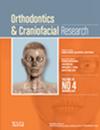This retrospective single-centre study aimed to compare the efficacy of maxillary second molar intrusion with two different approaches, miniscrew-assisted molar intrusion and traditional segmental archwire intrusion, and to compare orthodontically induced external apical root resorption (OIERR) during intrusion between two groups via cone beam computed tomography (CBCT).
A total of 40 adult patients (33.6 ± 10.3 years old) with supraerupted maxillary second molars due to the loss of antagonistic teeth were recruited, with 20 patients in each group. A segmental archwire with adjacent teeth as an anchorage was used in the control group, and 60–100 g of intrusive force was applied by using miniscrews in the experimental group to intrude the overerupted molars. Full-volume CBCT was performed before and after intrusion, and the amount of intrusion and extent of OIERR of the overerupted molars were compared between the two groups.
Supraerupted maxillary second molars could be successfully intruded in an average of 5 months. There was more intrusive movement of the buccal and palatal cusps in the mininscrew group than that in the segmental archwire group (P < .05). The intrusive amount of palatal cusp was 3.67 ± 1.13 mm in the miniscrew group and 2.38 ± 0.74 mm in the segmental archwire group. More palatal OIERR was observed in the miniscrew group (30.3 ± 11.6 mm3) than in the segmental archwire group (21.0 ± 8.66 mm3) (P = .0063). There was no significant difference in OIERR between the two groups for mesial and distal buccal roots (P > .05).
Miniscrews help effectively with supraerupted maxillary second molar intrusion, especially for palatal cusps. There was more OIERR in the palatal root when using miniscrews compared to the segmental archwire approach.


